Cite this document
(“Forensic Psychophysiology (Polygraph): The Other Forensic Science Essay”, n.d.)
Forensic Psychophysiology (Polygraph): The Other Forensic Science Essay. Retrieved from https://studentshare.org/miscellaneous/1540046-forensic-psychophysiology-polygraph-the-other-forensic-science
Forensic Psychophysiology (Polygraph): The Other Forensic Science Essay. Retrieved from https://studentshare.org/miscellaneous/1540046-forensic-psychophysiology-polygraph-the-other-forensic-science
(Forensic Psychophysiology (Polygraph): The Other Forensic Science Essay)
Forensic Psychophysiology (Polygraph): The Other Forensic Science Essay. https://studentshare.org/miscellaneous/1540046-forensic-psychophysiology-polygraph-the-other-forensic-science.
Forensic Psychophysiology (Polygraph): The Other Forensic Science Essay. https://studentshare.org/miscellaneous/1540046-forensic-psychophysiology-polygraph-the-other-forensic-science.
“Forensic Psychophysiology (Polygraph): The Other Forensic Science Essay”, n.d. https://studentshare.org/miscellaneous/1540046-forensic-psychophysiology-polygraph-the-other-forensic-science.


